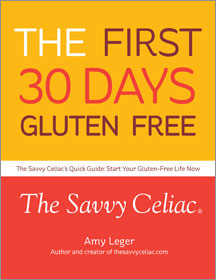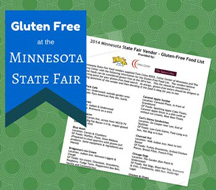Take Action: Tell FDA What You Think About Gluten Free Labeling Proposal
August 3, 2011 by Amy Leger | G+ Amy LegerThe Food and Drug Administration is moving forward with the gluten-free labeling initiative required by the Food Allergen Labeling and Consumer Protection Act of 2004.
Starting today until October 3rd, you can tell the FDA what you think about the proposed rule for voluntary gluten-free labeling in this country.
Access the FDA’s link to comment about gluten-free labeling
(Online instructions and US Mail information is below)
Late Tuesday afternoon the FDA did a teleconference about the proposal, and where things go from here. They explained this is public comment time the next step before unveiling the final rule in, what they say will likely be, the third quarter of 2012 (or probably a year or so from now).
At this time, the FDA is considering a proposal declaring 20 parts per million (ppm) or less of gluten in any food should be the standard for labeling something gluten free. Should that be the rule? Should it be something else? They want to hear from all of us. Michael Taylor, Deputy Commissioner for Foods for the FDA, said today, “We want to make certain that those with celiac [disease] avoid adverse health consequences..but at the same time we want to meet the needs of the consumers.”
So with the bottom line of getting people to submit their comments, they opened the teleconference to questions.
Getting to this point
I asked them what they have been doing since the most recent proposal back in 2007 . Now keep in mind I asked my question because they were required by FALCPA to have the proposed rule done 4 years after the 2004 enactment of the food allergen labeling law. Meaning it should have been complete by 2008. Taylor answered, “The time since original proposal has been devoted to safety evaluation that we committed to doing when we promised the proposal…you can see it online. It is a painstaking process. Then subject to peer review. Wanted to address every scientific avenue.”
I didn’t love that answer, but the safety assessment confirms they hired a firm in August of 2008 to conduct it and it appears the report was complete in December of 2010.
I also asked how the Gluten Free Labeling Summit this spring helped get them where they are today. Taylor said, “From my standpoint, the summit this spring underscored the importance of this rule making for the celiac community. The FDA appreciates that. This is one of those cases where our rules have a direct impact.”
I went to Jules Shepard co-organizer of the summit to see what thought about that answer?
“Their inaction led to our decision to hold the Gluten-Free Labeling Summit and to build the World’s Tallest Gluten Free Cake to draw attention to this very real labeling crisis,” Shepard said.
Nonetheless she’s pleased about the news, “It’s impressive that less than three months later we finally have action from the FDA. Particularly when we’re talking about government time, that’s real movement.”
Her co-organizer John Forberger told me this,
“Building the world’s largest gluten-free cake at the Gluten-Free Food Labeling Summit back in May was always seen as an appetizer. Now the entree is here (60-day Public Comment) and the dessert (standard) is in the freezer, but eventually will see its way out of the FDA’s kitchen. Hearing from the FDA so quickly after our event certainly reassures us the government is listening to our ever-growing community and it’s refreshing to hear they comprehend the ‘1in133’ nationwide movement is not a one-trick pony.”
Cross contamination & Labeling
One of the most interesting parts of the call was when Gluten Free Dee asked about gluten free tortillas or chips that show gluten free ingredients, and claim gluten free status, but may be cross contaminated because of the environment in which they are made. Would they still be listed as gluten free?
The FDA was very clear, “I don’t care where it [the food] comes from (even if ingredients are naturally gluten free).. If it’s cross contaminated and it’s over 20 ppm you cannot make the gluten free claim.” I loved that quote because is was decisive and firm.
Other notes
Enforcement: The FDA explained they had different possibilities in enforcing the law, and that will be explained in the compliance program when the final rule comes out. They said this could include inspections, samples for analysis, and/or label review.
Punishment: When asked what kind of punishment a company would face if they were caught not abiding the law, the FDA said, it could be one of several things…”a warning letter, noting the violation and asking for plans to correct it. Possible court enforcement…mandatory recall.”
Physician Support: Shepard was impressed (as was I) that Drs. Alessio Fassano (from U of Maryland) and Stefano Guandalini (U of Chicago) were on the call. “Having [them] call in to endorse the less than 20 ppm standard and to emphasize the need for this standard to be set as soon as possible speaks volumes about the hard science behind this standard,” Shepard said.
The “stakeholder” Teleconference call: Forberger acknowledged what so many said during the call, a big thank you to the FDA for discussing this with us. “Speaking on behalf of millions of American celiacs, it’s respectable the FDA held a teleconference and allowed for a two-way conversation. However, the conversation is just beginning and does not end when the government members and invited ‘stakeholders’ finished the call.” Indeed there is a lot of work yet to be done.
I look forward to hearing more and I hope the FDA will stay on time with it’s plan of unveiling the official rules in the third quarter of 2012.
Whether you agree with what they’re doing or not, please take time to submit your comments between today and the deadline of October 3rd. All opinions are welcome.
To submit your comments electronically to the docket go to www.regulations.gov
1. Choose “Submit a Comment” from the top task bar
2. Enter the docket number FDA-2005-N-0404 in the “Keyword” space
3. Select “Search”
Available after Noon EST August 3, 2011
To submit your comments to the docket by mail, use the following address:
The Division of Dockets Management
HFA-305
Food and Drug Administration
5630 Fishers Lane, Room 1061
Rockville, MD 20852
Include docket number FDA-2005-N-0404 on each page of your written comments.
Resources:
Shepard and 1in133.org are providing additional resources on this subject.
By the end of the week, go to 1in133.org to see suggested comments and links on this subject.
And on Thursday night she will have Andrea Levario of the American Celiac Disease Alliance on her Blog Talk Radio show – just search Jules Gluten Free.
Tags: celiac, FDA, gluten-free, labeling



August 12th, 2011 at 7:26 pm
Four hours ago, I learned that lab reports indicate that I may have celiac disease. I’m very surprised to learn that labels do not indicate information regarding gluten. Previously, I did not attend to information about gluten. How am I to easily regulate my food intake without such information? I hope that the upper GI does not confirm the working diagnosis, for control seems unnecessarily difficult without appropriate labeling.
August 13th, 2011 at 10:24 am
Shirley, Here are a few things you should know…you should stay on gluten until you get your biopsy which is the gold standard for diagnosis.
If it is positive, then you go gluten free. That means no wheat, barley, rye and some oats. I have a post that could help (specifically with the oats question and what ingredients are safe and not safe for celiac folks): http://thesavvyceliac.com/quick-guide-for-new-adult-celiacs/
But you’ve inspired a few necessary posts as well that I hope I can get to in the next week!
Bottom line on label reading, right now the Government requires companies to list wheat (and a handful of other top allergens) if it a source hidden in an ingredient. Gluten has been done recently but is purely voluntary(while some do it, MANY MANY do not) and not regulated, which is what this post is talking about.
So while the gf label will be great next year, since it won’t be mandatory by the US govt you’ll still have to learn how to read labels.
You’ll often be asking questions to companies like “what’s in your natural flavorings”– if it’s wheat, it will be listed. If it’s rye or barley it won’t which is why you always need to double check.
Good luck! Feel free to ask questions on my Facebook Fan page http://www.facebook.com/TheSavvyCeliac We always have a very good conversation going on over there!
August 22nd, 2011 at 7:17 pm
Although I deeply appreciate the actions of our various celiac groups on our behalf, I have a different point of view when it comes to labeling. I believe that using a two-tiered system such as the ones adopted by Australia and New Zealand will create standards that are very natural and intuitive, and will eliminate confusion for everyone whose lives are impacted by celiac disease, including people who do not have an informed understanding of what it means to be gluten free. There is nothing prohibitive or confusing about it if it is done correctly.
Toward this end, I very much prefer labeling
August 23rd, 2011 at 2:21 pm
AS ALWAYS, a thorough, topical and well-balanced post! Thanks. There has been far too little discussion about this important development.
We have delved into the FDA safety assessment document and have made a number of observations which some of your readers might find valuable:
Proposed FDA Standard for Gluten-Free Foods (20 ppm) May Not Adequately Protect the Food Supply for Celiacs